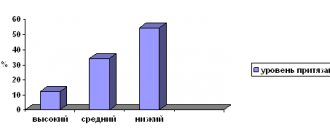Expression is a concept synonymous with expressiveness, intensity, brightness of manifestation and presentation of one’s emotional state, feelings, experiences. In addition, the term expression can be used to refer to indirect messages and thoughts of a person in non-verbal form (tears, hysterics, exclamations, etc.). Those. expression does not affect the descriptive side of the state, when a person is able to reflect on what is happening, but the immediate moment of being, living an emotion, its implementation in external space.
The word expression realizes its meaning exclusively on the external plane of personality manifestation. The strength and quality of personality is largely determined by innate characteristics associated with temperament, strength and mobility of the nervous system, pace, amplitude and intensity of mental processes. Expression expresses the meaning for a person of another or an event that has occurred, and expresses both the degree of importance and the direction (positive or negative).
Expressive components of manifestation in the outside world reflect the status of the individual (acceptance by society leads to greater expressiveness), as well as belonging to a particular culture or community (for example, Italians are more expressive than Estonians). The level of development of communication skills is also manifested through the degree of development of expressive manifestations and their adequate use to create socially acceptable forms of behavior. In addition to such external factors, expression serves as an excellent regulator of the internal state of the individual, providing a way of emotional release during stress.
Expression largely serves to control and regulate relationships, allowing one to establish a certain optimal closeness of distance and change the nature of interaction. Thus, expressively expressed anger will push away an unwanted interlocutor, and an equally strongly expressed joy at the appearance of a person will contribute to rapprochement. Vivid expression of one’s own feelings allows one to give communication a certain form: conflict, clarification, interaction, agreement, submission, etc.
Determination of expression
What is expression? In medicine, it is a genetic process by which the information contained in genes is converted into specific cellular structures. Expressiveness in biology is a definition inextricably linked with human life and health, which is further developed in psychology and psychotherapy. The concept of “express” belongs to the same medical-biological field - this means to transcribe and broadcast a gene.
Expressiveness is the degree of expression of a certain state, feeling, emotion, attitude. The concepts of “expressiveness” and “expression” are used not only in psychology, but also in theater studies and art history, if it is necessary to emphasize the level of expression of spirituality. And also show means of expression, for example, painting, music, architectural elements. It turns out that in the existing definitions of these terms there are indications of the connection of this phenomenon with the mental and spiritual world of people.
Expression is the expressiveness of feelings and emotions, showing the internal state by manifesting it in appearance.
The opposite meaning is impressiveness - a tendency to internal rather than external experiences, the accumulation of predominantly negative feelings. They say about such people that they keep their experiences to themselves, are not inclined to share emotions and problems, grievances and frustrations do not come to them immediately, not instantly.
Opinions about the connection between the inner world of people and expression, which were formed mostly in art history and philosophy, are supplemented by psychology. The essence of this connection in psychological expression is visible in the fact that expression takes place not only as accompaniment of actions externally. It acts as a part of these phenomena, a form of their manifestation.
Expressive girl telling something to her friend
For this reason, it is worth talking about expression in the form of personal education , a way of knowing the spiritual world of the individual, and also as an external “I”.
Expression in cinema and theater
Cinema and theater could not remain aloof from developing trends. The meaning of "expression" in these art movements is more narrow and characterizes a short-lived phase in German theater and cinema, which nevertheless greatly influenced modern art. When talking about these forms of creativity, the word “expression” itself is rarely used as a compliment or characteristic. But the standard of expressive cinema, the 1920 feature film The Cabinet of Dr. Caligari, is often cited as the world's first successful full-length horror film.
Expressive behavior
In science, personal expressive behavior means a combination of persistent and changing means of expression that are organized into various types of structures. They are rebuilt in the process of creating social and psychological personal qualities.
Such a combination of means includes parts that have different developments of change, and also differ in the level of effort required for this purpose. So, the composition of personal expressive behavior contains parts that have a high level of inconstancy (facial expressions, intonation), including medium and low levels. If a person is expressive, this also includes physiognomic elements of expressiveness; clothing and hairstyle belong to the average level of inconstancy. There is also the concept of “human expressive repertoire,” which means a set of postures, intonations, gestures, facial expressions and their combinations for various communication situations.
What is an expressive person? This means that the behavior of an individual is a constantly changing self-sculpting. Our body is a mirror that reflects the action of appearance and soul. Internal personality changes lead to external changes . For this reason, appearance is not a random combination of elements, but a strict, clear reflection of personal characteristics.
In experimental science, the unstable elements of expression . It is a combination of movements that constantly change according to the position and attitude of the person. Such movements are shown using an optical system. Visual communication methods by psychologists include kinesics. It represents the breadth of movements, which is perceived visually and carries different information from different points of view of the partners. It includes only demonstrative gestures and poses with clear semantics.
Expressive people are characterized by emotional, expressive behavior
Expressive actions in the form of the external “I” are associated with its unstable and persistent substructures. It is a valid indicator of many personality traits . It can be viewed as:
manifestations of expressive elements of general personal activity, which is associated with temperament; expressive composition of mental states; an indicator of the modality of signs of connection between one person and another; ways of expressing qualities; a sign of personality development as a subject of communication; showing expressive elements of a person’s social status; hiding the external “I” of the individual; way of demonstrating and creating acceptable behavior.
Correction
Correcting delayed development of expressive and impressive speech requires an integrated approach.
The specific set of measures taken is determined by the speech therapist, taking into account the actual data of a particular small patient:
- nootropic drugs (stimulate the activity of cells in the cerebral cortex, which improves memory in children, enhances attention, the ability to concentrate, normalizes sleep and general mental state, and so on);
- physiotherapeutic procedures (for example, microcurrent therapy, which involves the active impact of minimal current discharges on biologically active areas of the cerebral cortex);
- developmental classes with a speech therapist and defectologist (specialists focus their efforts on improving the little person’s memory and general development of thinking);
- speech therapy massage (a complex effect on the facial muscles, promoting the development of speech in a small person);
- performing play-based exercises aimed at developing facial muscles (for example, “Clock”, in which a 2-3 year old child needs to stick out his tongue and move it from side to side; onomatopoeic exercises (imitation of rain, animal voices, etc.) or voicing poems (the adult shows - the child voices his actions, after which the roles change).
Expressive and impressive speech should normally be developed in children at a basic level by the age of 4-5 years. In speech therapy, there are a large number of ways to stimulate a child’s ability to correctly express his thoughts, which he can practice not only with a specialist, but also at home alone with his parents.
Despite the importance of the speech aspect in the overall development of a growing person, adults are not recommended to put moral pressure on the child and force him to study. Instead, you should talk to him as much as possible, take an interest in the child’s opinion and expand his horizons.
Expressiveness of personality
Personal expressiveness is the ability to clearly and vividly show one’s own feelings, emotions and attitudes. This concept is the opposite of restraint. According to A. Maslow, in a normal personality both traits exist in harmony and balance. An adequate personality is not just spontaneous: she is spontaneous and expressive when she wants it . She is able to relax, give up control when it is appropriate. But such a person is also capable of controlling himself, postponing gratification, showing politeness, etc.
The accompanying qualities of expressiveness lack deliberation, caution, rationality and self-control. Its companions are excitability, suddenness and enthusiasm.
Our soul is characterized by natural beauty. Depending on the personality qualities that determine the demonstration of the energy of the soul, instinctiveness, temperament, and enthusiasm . And if the energy of the soul is determined by vices, then unbridledness and excessive emotionality are manifested in the outside world.
An expressive person expresses all emotions and feelings brightly and unrestrainedly. It is characterized by excessive excitability.
The word "expression" comes from Latin - expressio, which means pumping and squeezing . Expression is the external expression of experiences and emotions in the first place. This includes tears, hysteria, exclamations, emotional gestures, sadness, screams, and apathetic state. In the linguistics of the Russian language there is the term “expresseme” - this is a stylistic unit that serves to reveal expressive constructions.
Each culture interprets expressiveness as a personality trait differently. A Spaniard who actively gesticulates in the Baltic countries will be considered an expressive person. But in his homeland he will be mistaken for a melancholy person. It turns out that the manifestation of expression is largely determined by the peculiarities of culture.
An expressive personality shows all emotions and feelings brightly, unrestrainedly
In psychology, emotional expression is expressiveness, the power of manifestation of feelings and experiences. It is considered as an extensive set of means, using which a person shows his abilities to others. Expressionist artists were able to “catch” expression in the form of showing emotions. If viewers are able to see the expression of emotions in the works, then they are considered expressive.
What are PD1 and PD-L1, and what is their role in cancer treatment?
The human immune system operates complex mechanisms through which it distinguishes “strangers” from “friends.” If their work is disrupted, the immune system can “sleep through” a serious infection, or, conversely, begins to behave aggressively and attack normal tissues, mistaking them for strangers. This self-regulation is carried out due to special signaling molecules and their receptors, which are located on the surface of cells.
Immune suppressive receptors and their ligands (molecules that bind to the receptor and cause specific effects) are called checkpoints . This class of substances includes the membrane protein - programmed cell death receptor PD1 and its ligand PD-L1.
The PD1 protein is embedded in the membrane of immune cells - T-lymphocytes. PD-L1 is expressed on the surface of other immune cells that interact with T lymphocytes, as well as cells of other tissues - mucous membranes, the inner lining of blood vessels. When PD1 and PD-L1 interact, the proliferation of T-lymphocytes slows down and their activity decreases.
Some cancer cells use this mechanism. They display PD-L1 on their surface and thus seem to say to the lymphocytes: “we are our own, we don’t need to be attacked.”
Immunotherapy drugs from the group of checkpoint inhibitors help “awaken” the immune system. They are monoclonal antibodies (analogues of human antibodies) that bind to PD1 or PD-L1 and thereby block them. Transmission of the molecular signal that suppresses T-cell activity stops. The immune system begins to recognize and attack the tumor again.
In 2014, two PD-1 inhibitors were approved in the United States: pembrolizumab (Keytruda) and nivolumab (Opdivo) to fight metastatic melanoma. In 2020, they were approved for the treatment of patients suffering from non-small cell lung cancer (NSCLC). PD-L1 inhibitors include atezolizumab (Tecentriq), avelumab (Bavencio), and durvalumab (Imfinzi). PD1 and PD-L1 blockers are already licensed for the treatment of various types of cancer and currently continue to be investigated in more than 1000 clinical trials.
Why perform PD-L1 expression analysis?
With the advent of checkpoint inhibitors, a new era has begun in the development of oncology. Doctors now have an effective tool to combat late-stage malignant tumors. Remission in metastatic cancer is still generally impossible, but immunotherapy drugs can help improve survival rates for these patients and slow the progression of the disease when other treatments fail.
However, there are also some problems. Checkpoint inhibitors don't work for everyone. They are effective only in cases where there is increased expression of the corresponding target molecules, in particular PD1 and PD-L1. Unreasonable prescription of immunotherapy drugs is unacceptable, because, despite all their advantages, they can cause very serious side effects. Medicines are very expensive because the manufacturer must recoup the huge funds invested in their development and clinical research.
It is important for an oncologist to clearly determine which patients will benefit from checkpoint inhibitors and whether there are compelling reasons to prescribe them in a particular case. Analysis of PD-L1 expression helps with this.
Bottom line
Expressiveness is an acceptable expression of one's emotions and feelings. The outcome of such communication depends not only on how the speaker conveys his thoughts, but also on the attitude of the listener to what is said to him. Disputes often arise here if the listener does not agree with what is being said. However, expressiveness continues both in a situation of conflict between interlocutors and in a situation of agreement between the listener and the speaker.
Expressiveness includes three components:
- The speaker's intentions.
- Initial knowledge and data with which the listener enters into dialogue.
- Method of transmitting information.
It should be noted that modern people are increasingly resorting to obscene language as one way of conveying their emotions. Often in such cases the individual says: “I can’t call it any other way!” Through swearing and obscene language, he can express his own attitude towards the interlocutor, phenomenon or what is happening. The more often he pronounces these words, the more he begins to use them, even in situations that do not carry such a bright emotional coloring.
Expressiveness is often interpreted as a speech concept that is reflected in various ways of conveying information. In fact, expressiveness depends to a large extent on the emotions that a person experiences. If there were no experiences, then there would be no expressiveness. The fewer barriers a person experiences in expressing his emotions, the more expression appears in his speech.










